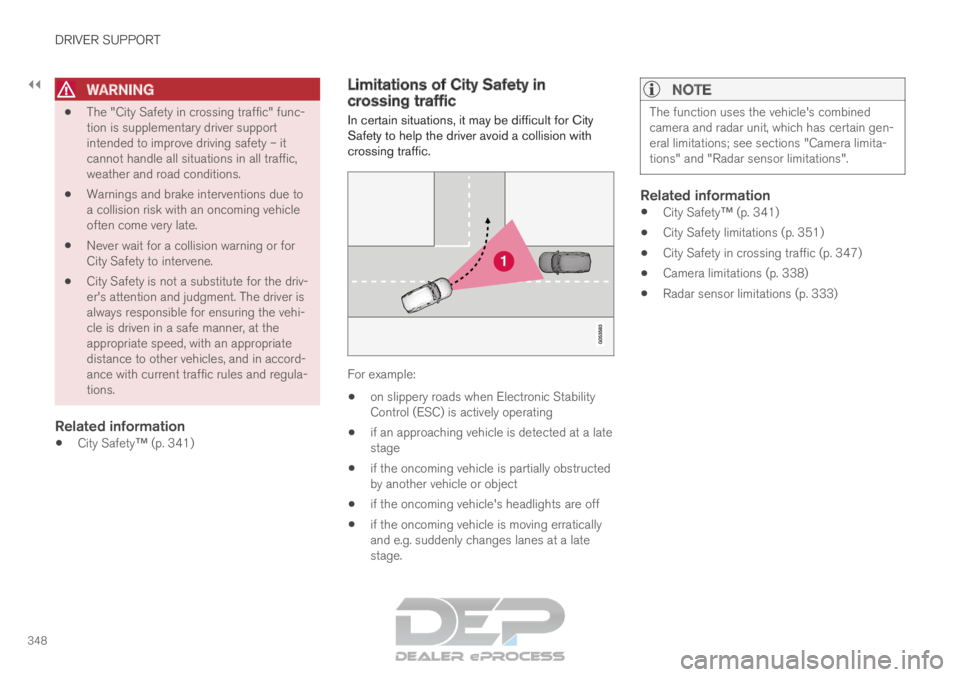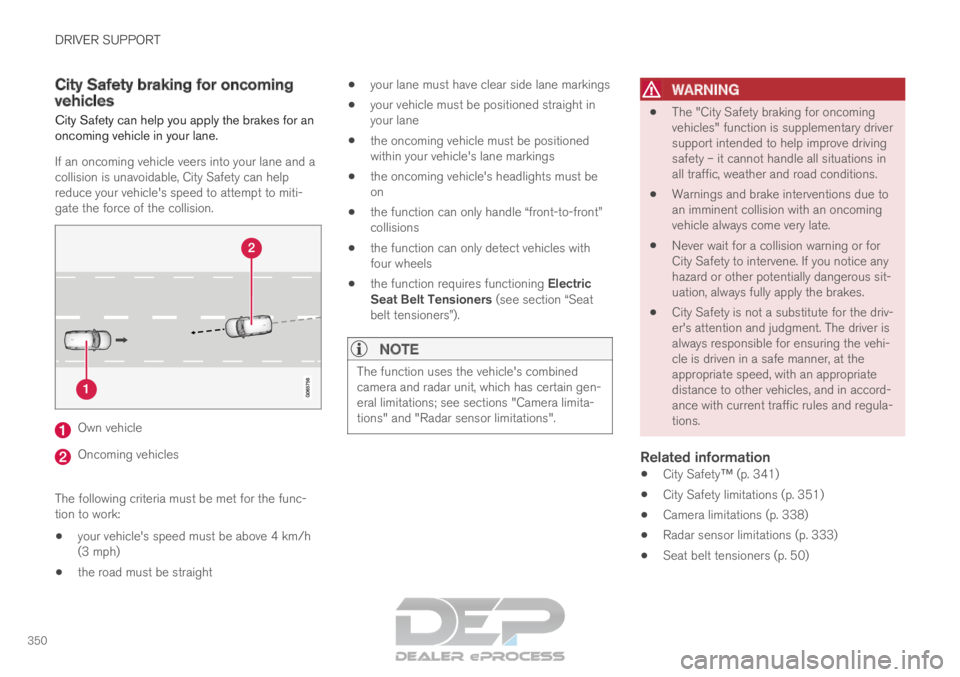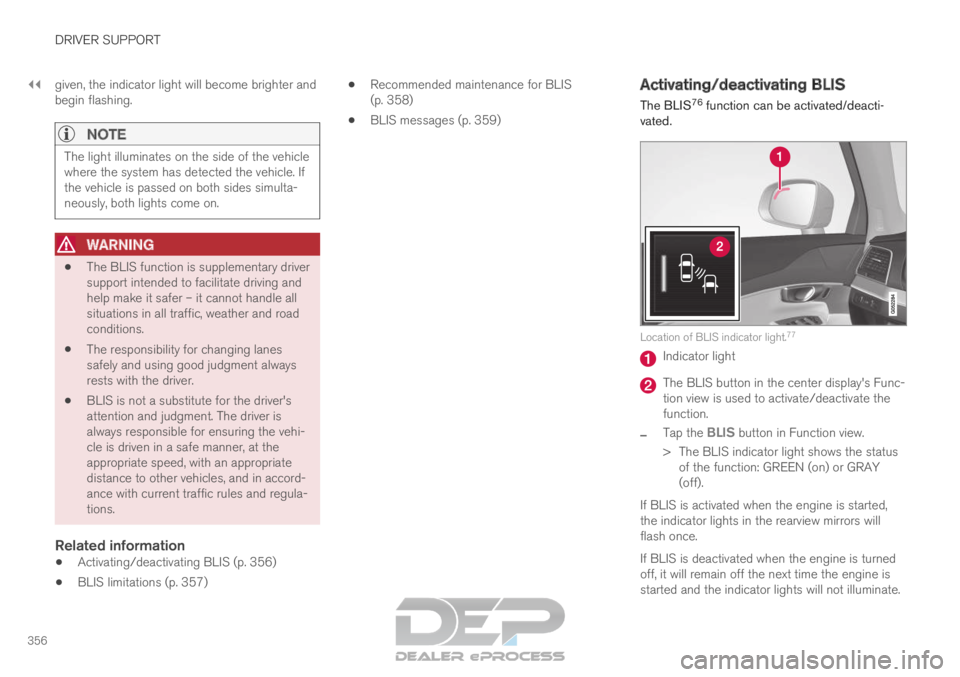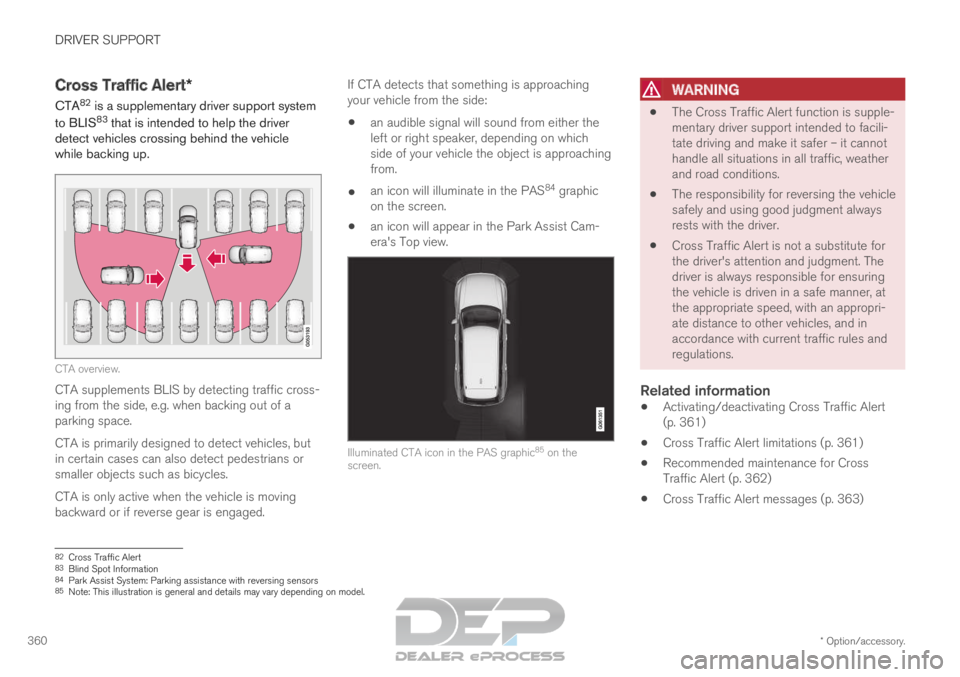ESP VOLVO XC90 TWIN ENGINE 2019 Service Manual
[x] Cancel search | Manufacturer: VOLVO, Model Year: 2019, Model line: XC90 TWIN ENGINE, Model: VOLVO XC90 TWIN ENGINE 2019Pages: 697, PDF Size: 10.33 MB
Page 350 of 697

||DRIVER SUPPORT
348
WARNING
The "City Safety in crossing traffic" func-
tion is supplementary driver support
intended to improve driving safety – it
cannot handle all situations in all traffic,
weather and road conditions.
Warnings and brake interventions due to
a collision risk with an oncoming vehicle
often come very late.
Never wait for a collision warning or for
City Safety to intervene.
City Safety is not a substitute for the driv-
er's attention and judgment. The driver is
always responsible for ensuring the vehi-
cle is driven in a safe manner, at the
appropriate speed, with an appropriate
distance to other vehicles, and in accord-
ance with current traffic rules and regula-
tions.
Related information
City Safety™ (p. 341) Limitations of City Safety in
crossing traffic
In certain situations, it may be difficult for City
Safety to help the driver avoid a collision with
crossing traffic. For example:
on slippery roads when Electronic Stability
Control (ESC) is actively operating
if an approaching vehicle is detected at a late
stage
if the oncoming vehicle is partially obstructed
by another vehicle or object
if the oncoming vehicle's headlights are off
if the oncoming vehicle is moving erratically
and e.g. suddenly changes lanes at a late
stage.
NOTE The function uses the vehicle's combined
camera and radar unit, which has certain gen-
eral limitations; see sections "Camera limita-
tions" and "Radar sensor limitations".
Related information
City Safety™ (p. 341)
City Safety limitations (p. 351)
City Safety in crossing traffic (p. 347)
Camera limitations (p. 338)
Radar sensor limitations (p. 333)
Page 351 of 697

DRIVER SUPPORT
349
City Safety and delayed evasive
maneuvers
City Safety can assist the driver by automatically
braking the vehicle when it is not possible to
avoid a collision by steering alone.
City Safety assists the driver by periodically
attempting to predict possible "escape routes" to
the sides of the vehicle in the event a slow-mov-
ing or stationary vehicle were to be detected at a
late stage.
Your vehicle (1) cannot detect any potential escape
routes for veering away from the vehicle ahead (2) and
may therefore apply the brakes at an earlier stage.
Own vehicle
Slow-moving/stationary vehicles
City Safety will not intervene to automatically
apply the brakes if it is possible for the driver to
avoid a collision by steering the vehicle. However, if City Safety determines that an eva-
sive maneuver would not be possible due to traf-
fic in the adjacent lane(s), the function can assist
the driver by automatically starting to apply the
brakes at an earlier stage.
WARNING
The possibility of City Safety predicting a
certain situation is supplementary driver
support intended to improve driving safety
– it cannot handle all situations in all traf-
fic, weather and road conditions.
City Safety is not a substitute for the driv-
er's attention and judgment. The driver is
always responsible for ensuring the vehi-
cle is driven in a safe manner, at the
appropriate speed, with an appropriate
distance to other vehicles, and in accord-
ance with current traffic rules and regula-
tions.
Limitations of City Safety during evasive
maneuvers
NOTE The function uses the vehicle's combined
camera and radar unit, which has certain gen-
eral limitations; see sections "Camera limita-
tions" and "Radar sensor limitations".
Related information
City Safety™ (p. 341)
Camera limitations (p. 338)
Radar sensor limitations (p. 333)
Page 352 of 697

DRIVER SUPPORT
350City Safety braking for oncoming
vehicles
City Safety can help you apply the brakes for an
oncoming vehicle in your lane.
If an oncoming vehicle veers into your lane and a
collision is unavoidable, City Safety can help
reduce your vehicle's speed to attempt to miti-
gate the force of the collision. Own vehicle
Oncoming vehicles
The following criteria must be met for the func-
tion to work:
your vehicle's speed must be above 4 km/h
(3 mph)
the road must be straight
your lane must have clear side lane markings
your vehicle must be positioned straight in
your lane
the oncoming vehicle must be positioned
within your vehicle's lane markings
the oncoming vehicle's headlights must be
on
the function can only handle “front-to-front”
collisions
the function can only detect vehicles with
four wheels
the function requires functioning Electric
Seat Belt Tensioners (see section “Seat
belt tensioners”).
NOTE The function uses the vehicle's combined
camera and radar unit, which has certain gen-
eral limitations; see sections "Camera limita-
tions" and "Radar sensor limitations".
WARNING
The "City Safety braking for oncoming
vehicles" function is supplementary driver
support intended to help improve driving
safety – it cannot handle all situations in
all traffic, weather and road conditions.
Warnings and brake interventions due to
an imminent collision with an oncoming
vehicle always come very late.
Never wait for a collision warning or for
City Safety to intervene. If you notice any
hazard or other potentially dangerous sit-
uation, always fully apply the brakes.
City Safety is not a substitute for the driv-
er's attention and judgment. The driver is
always responsible for ensuring the vehi-
cle is driven in a safe manner, at the
appropriate speed, with an appropriate
distance to other vehicles, and in accord-
ance with current traffic rules and regula-
tions.
Related information
City Safety™ (p. 341)
City Safety limitations (p. 351)
Camera limitations (p. 338)
Radar sensor limitations (p. 333)
Seat belt tensioners (p. 50)
Page 354 of 697

||DRIVER SUPPORT
352
Other limitations
WARNING
Warnings and brake interventions can be
triggered late or not at all if the traffic sit-
uation or external influences prevent the
camera and radar unit from properly
detecting pedestrians, cyclists, large ani-
mals or vehicles ahead of the vehicle.
To be able to detect vehicles at night, its
front and rear lights must work and illumi-
nate clearly.
The camera and radar unit have a limited
range for pedestrians and cyclists – the
system can provide effective warnings
and brake interventions if the relative
speed is lower than 50 km/h (30 mph).
For stationary or slow-moving vehicles,
warnings and brake interventions are
effective at vehicle speeds of up to
70 km/h (43 mph). Speed reduction for
large animals is less than 15 km/h
(9 mph) and can be achieved at vehicle
speeds over 70 km/h (43 mph). At lower
speeds, the warning and brake interven-
tion for large animals is less effective.
Warnings for stationary or slow-moving
vehicles and large animals can be disen-
gaged due to darkness or poor visibility.
Warnings and brake interventions for
pedestrians and cyclists are disengaged
at vehicle speeds over 80 km/h
(50 mph).
Do not place, affix or mount anything on
the inside or outside of the windshield, or
in front of or around the camera and
radar unit – this could disrupt camera-
based functions.
Objects, snow, ice or dirt in the area of
the camera sensor can reduce the func-
tion, disengage it completely or give an
improper function response.
NOTE The function uses the vehicle's combined
camera and radar unit, which has certain gen-
eral limitations; see sections "Camera limita-
tions" and "Radar sensor limitations".
Market limitationsCity Safety is not available in all countries. If City
Safety is not shown in the center display's
Settings menu, your vehicle is not equipped with
this function.
In the center display's Top view, tap:
Settings My Car IntelliSafe
Related information
City Safety™ (p. 341)
Camera limitations (p. 338)
Radar sensor limitations (p. 333)
Page 358 of 697

||DRIVER SUPPORT
356
given, the indicator light will become brighter and
begin flashing.
NOTE
The light illuminates on the side of the vehicle
where the system has detected the vehicle. If
the vehicle is passed on both sides simulta-
neously, both lights come on.
WARNING
The BLIS function is supplementary driver
support intended to facilitate driving and
help make it safer – it cannot handle all
situations in all traffic, weather and road
conditions.
The responsibility for changing lanes
safely and using good judgment always
rests with the driver.
BLIS is not a substitute for the driver's
attention and judgment. The driver is
always responsible for ensuring the vehi-
cle is driven in a safe manner, at the
appropriate speed, with an appropriate
distance to other vehicles, and in accord-
ance with current traffic rules and regula-
tions.
Related information
Activating/deactivating BLIS (p. 356)
BLIS limitations (p. 357)
Recommended maintenance for BLIS
(p. 358)
BLIS messages (p. 359) Activating/deactivating BLIS
The BLIS
76
function can be activated/deacti-
vated. Location of BLIS indicator light.
77 Indicator light
The BLIS button in the center display's Func-
tion view is used to activate/deactivate the
function.
– Tap the
BLIS button in Function view.
>
The BLIS indicator light shows the status
of the function: GREEN (on) or GRAY
(off).
If BLIS is activated when the engine is started,
the indicator lights in the rearview mirrors will
flash once.
If BLIS is deactivated when the engine is turned
off, it will remain off the next time the engine is
started and the indicator lights will not illuminate.
Page 362 of 697

DRIVER SUPPORT
* Option/accessory.
360 Cross Traffic Alert*
CTA 82
is a supplementary driver support system
to BLIS 83
that is intended to help the driver
detect vehicles crossing behind the vehicle
while backing up. CTA overview.
CTA supplements BLIS by detecting traffic cross-
ing from the side, e.g. when backing out of a
parking space.
CTA is primarily designed to detect vehicles, but
in certain cases can also detect pedestrians or
smaller objects such as bicycles.
CTA is only active when the vehicle is moving
backward or if reverse gear is engaged. If CTA detects that something is approaching
your vehicle from the side:
an audible signal will sound from either the
left or right speaker, depending on which
side of your vehicle the object is approaching
from.
an icon will illuminate in the PAS 84
graphic
on the screen.
an icon will appear in the Park Assist Cam-
era's Top view. Illuminated CTA icon in the PAS graphic
85
on the
screen.
WARNING
The Cross Traffic Alert function is supple-
mentary driver support intended to facili-
tate driving and make it safer – it cannot
handle all situations in all traffic, weather
and road conditions.
The responsibility for reversing the vehicle
safely and using good judgment always
rests with the driver.
Cross Traffic Alert is not a substitute for
the driver's attention and judgment. The
driver is always responsible for ensuring
the vehicle is driven in a safe manner, at
the appropriate speed, with an appropri-
ate distance to other vehicles, and in
accordance with current traffic rules and
regulations.
Related information
Activating/deactivating Cross Traffic Alert
(p. 361)
Cross Traffic Alert limitations (p. 361)
Recommended maintenance for Cross
Traffic Alert (p. 362)
Cross Traffic Alert messages (p. 363) 82
Cross Traffic Alert
83 Blind Spot Information
84 Park Assist System: Parking assistance with reversing sensors
85 Note: This illustration is general and details may vary depending on mod\
el.
Page 366 of 697

DRIVER SUPPORT
* Option/accessory.
364 Road Sign Information*
The Road Sign Information (RSI
91
) function can
help the driver observe speed-related road
signs. Examples of signs that can be detected
92
. Example
92
of registered speed information.
If the vehicle passes a speed limit sign, it will be
displayed in the instrument panel and the head-
up display*.
NOTE In certain markets, the Road Sign Information
function (RSI) is only available in combination
with Sensus Navigation*.
WARNING
The Road Sign Information function is
supplementary driver support intended to
facilitate driving and help make it safer –
it cannot handle all situations in all traffic,
weather and road conditions.
Road Sign Information is not a substitute
for the driver's attention and judgment.
The driver is always responsible for
ensuring the vehicle is driven in a safe
manner, at the appropriate speed, with an
appropriate distance to other vehicles,
and in accordance with current traffic
rules and regulations.
Related information
Activating/deactivating Road Sign Informa-
tion (p. 365)
Road Sign Information and sign displays
(p. 366)
Road Sign Information and Sensus
Navigation (p. 366)
Road Sign Information with Speed Warning
and Settings (p. 367)
Activating/deactivating Speed Warning in
Road Sign Information (p. 368) 91
Road Sign Information
92 Road signs differ according to market ‒ the illustrations shown here are just some examples.
Page 373 of 697

DRIVER SUPPORT
371
WARNING
The Driver Alert Control function is sup-
plementary driver support intended to
facilitate driving and help make it safer –
it cannot handle all situations in all traffic,
weather and road conditions.
Driver Alert Control must not be used to
extend a period of driving. The driver
should plan in breaks at regular intervals
and make sure they are well rested.
Driver Alert Control is not a substitute for
the driver's attention and judgment. The
driver is always responsible for ensuring
the vehicle is driven in a safe manner, at
the appropriate speed, with an appropri-
ate distance to other vehicles, and in
accordance with current traffic rules and
regulations.
WARNING An alarm from Driver Alert Control should be
taken very seriously since a sleepy driver is
often not aware of their own condition.
If the alarm sounds or you feel fatigued:
Stop the vehicle safely as soon as possi-
ble and rest.
Studies have shown that it is just as danger-
ous to drive while tired as it is to drive under
the influence of alcohol or other stimulants.
Related information
Activating/deactivating Driver Alert Control
(p. 371)
Selecting guidance to a rest area if the
Driver Alert Control warning has been given
(p. 372)
Driver Alert Control limitations (p. 372) Activating/deactivating Driver Alert
Control
The Driver Alert Control (DAC) function can be
activated/deactivated.
On/OffTo change DAC settings:
1. Tap Settings in the center display's Top
view.
2.
Select My Car IntelliSafe Driver Alert
Control .
3. Select/deselect Alertness Warning to acti-
vate/deactivate DAC.
Related information
Driver Alert Control (p. 370)
Page 374 of 697

DRIVER SUPPORT
* Option/accessory.
372 Selecting guidance to a rest area if
the Driver Alert Control warning has
been given
The Rest Stop Guidance function can be
switched on or off.
In vehicles equipped with Sensus Navigation*, the
driver can activate a guide that can automatically
suggest a suitable rest stop if the DAC warning
is given.
To select Rest Stop Guidance:
1. Tap Settings in the center display's Top
view.
2.
Select My Car IntelliSafe Driver Alert
Control .
3. Select/deselect Rest Stop Guidance to
activate/deactivate the function.
Related information
Driver Alert Control (p. 370) Driver Alert Control limitations
Driver Alert Control (DAC) functionality may be
reduced in certain situations.
In certain situations, the system may provide a
warning even if it has not detected a change in
driving behavior, e.g.:
in strong crosswinds
on grooved road surfaces.
WARNING In certain cases, driving behavior might not be
affected despite the driver's fatigue – when
using the Pilot Assist function – resulting in
the driver not getting a warning from DAC.
It is therefore very important to always stop
and take a break at the slightest sign of fati-
gue, regardless of whether the DAC function
has issued a warning or not.
NOTE
The function uses the vehicle's camera unit,
which has some general limitations – see the
section "Camera unit limitations".
Related information
Driver Alert Control (p. 370)
Camera limitations (p. 338) Lane Keeping Aid
Lane Keeping Aid (LKA 104
) is designed to
actively steer the vehicle on freeways, highways
and other major roads to help the driver reduce
the risk of the vehicle unintentionally veering out
of the lane.
Lake Keeping Assistance steers the vehicle back
into the lane and/or alerts the driver using vibra-
tions in the steering wheel.
Lane Keeping Aid is active at speeds between
65-200 km/h (40-125 mph) on roads with
clearly visible traffic lane marker lines.
On narrow roads, the function may be unavailable
and go into standby mode. The function will
become available again when the road becomes
sufficiently wide. A camera monitors the road/traffic lane's marker lines.
104
Lane Keeping Aid
Page 375 of 697

DRIVER SUPPORT
}}
373 Lane Keeping Aid steers the vehicle back into its lane.
Lane Keeping Aid alerts the driver using vibrations in the
steering wheel
105
. Depending on the settings used, Lane Keeping
Aid functions in different ways:
With
Assist 106
activated: When the vehicle
approaches a lane marker line, LKA will
actively steer the vehicle back into the lane
using light pressure on the steering wheel.
With
Warning 106
activated: If the vehicle is
about to move over a lane marker line, the
driver will be alerted by vibrations in the
steering wheel.
NOTE When the direction indicator is activated, the
Lane Keeping Aid does not provide any warn-
ing or intervene with steering.
WARNING
The Lane Keeping Aid function is supple-
mentary driver support intended to help
improve driving safety – it cannot handle
all situations in all traffic, weather and
road conditions.
The function is not a substitute for the
driver's attention and judgment. The driver
is always responsible for ensuring the
vehicle is driven in a safe manner, at the
appropriate speed, with an appropriate
distance to other vehicles, and in accord-
ance with current traffic rules and regula-
tions. 105
The steering wheel vibrations vary. The more time the vehicle is over th\
e lane marker line, the longer the vibrations.
106 See "LKA assistance options" under "Activating/deactivating Lane Keeping\
Aid".